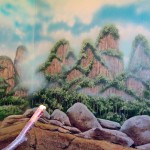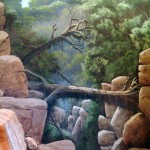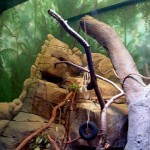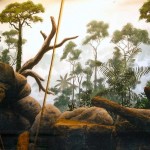In 2000 and 2006, I did several murals for Vic Camp, then director of the Como Zoo in St. Paul, Minnesota. The murals included exhibits for black lemurs, tamarinds, spider monkeys, saki monkeys, and orangutans.
As with buildings at many zoos, the primate building had originally been designed as a piece of architecture, and retrofitting it to look like natural environments with rocks, trees and murals was a challenge.
In 2013, the Zoo finally had the funding to finish the last exhibit, gorillas. The interior exhibit space remained unchanged except for the addition of my murals, but the Zoo expanded the outdoor space significantly and now have some pretty happy gorillas.
I learned a lot about primates from these jobs (see my Mostly True Tale Animals). Among the most interesting perspectives was Vic’s description of the different reactions each species had to being returned to their public exhibit space after having to stay in their night holding area for several days while I painted murals. Some were apparently oblivious of the murals while others had dramatic reactions.
The spider monkeys burst forth from their transfer doors in a riot of suppressed energy, wildly swinging from branch to branch, bouncing off rocks and walls. First one monkey, and then another, noticed the changes to their walls and froze. Within moments, as each one took notice of the reason for his compatriots’ paralysis, the exhibit became a silent tableau of monkey statues. Suddenly, one bold fellow attacked a wall, slapped it and retreated. When nothing bad happened, another one attacked. Once everyone had an opportunity to reassure themselves that the old walls were still in place, they all went back to their ecstatic celebration of freedom.
The lemurs, on the other hand, scampered out in a cluster, noticed the changes instantly and perched, back to back, atop a central rock promontory. One brave lemur inched forward up to a wall, barked at it, ran back and watched. Then a second eased forward, touched the wall and jumped back. He looked over his shoulder at the others and barked something, and they all relaxed, dispersed and went about their business.
The orangs, faithful to their Zen-like contemplative natures, each found a spot where they could survey the broad landscape before them. They seemed to understand that they were looking at misty mountains and broad skies. The alpha male eventually shuffled up to a wall and gently ran his hand over the surface. Once the others saw this, they seemed to understand that it was an illusion and busied themselves with other matters. But as recently as 2013, while I was passing across the back of their exhibit space to get to the gorillas’ enclosure, I would still see some of the senior orangs resting on a rock, apparently enjoying the view. I find that curiously more rewarding than the praise of any human client.







